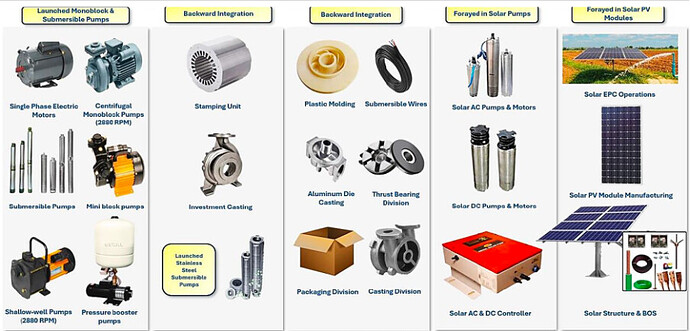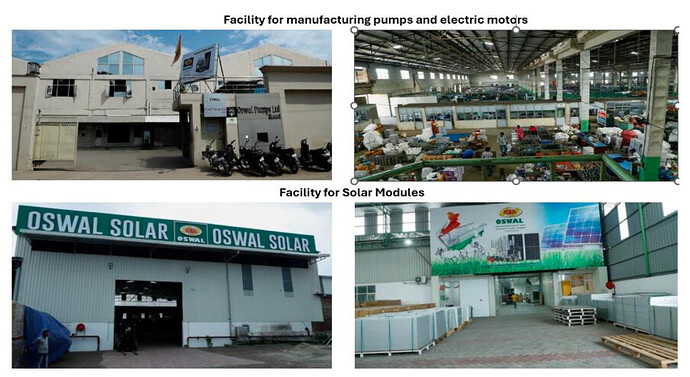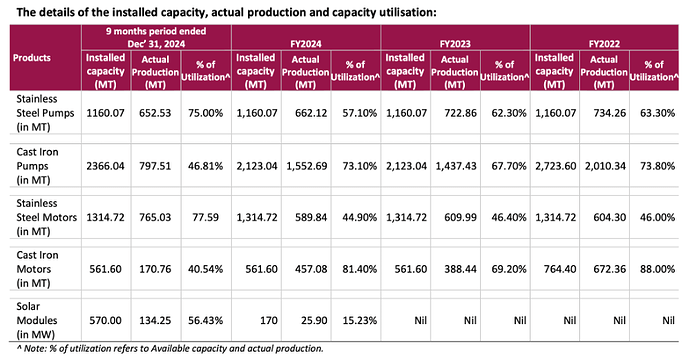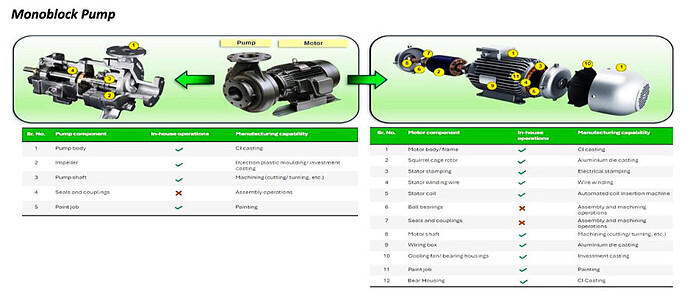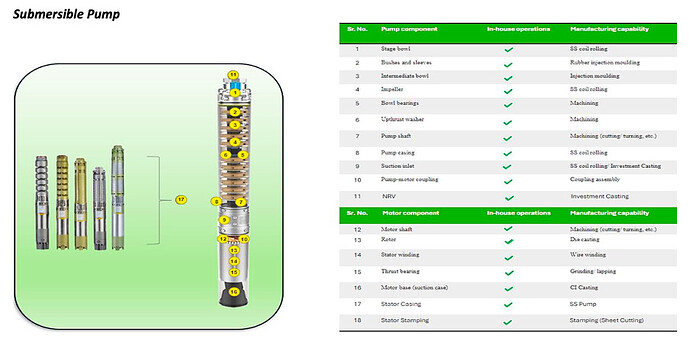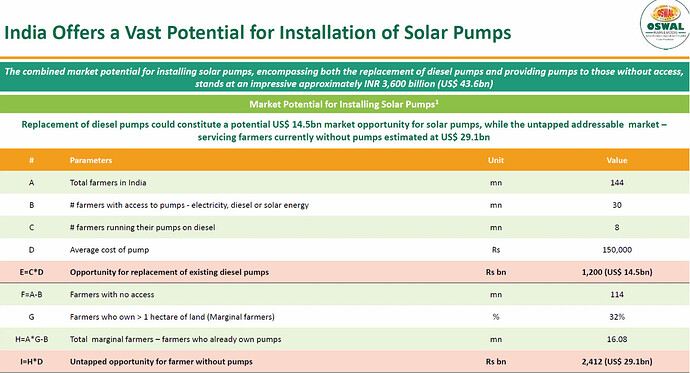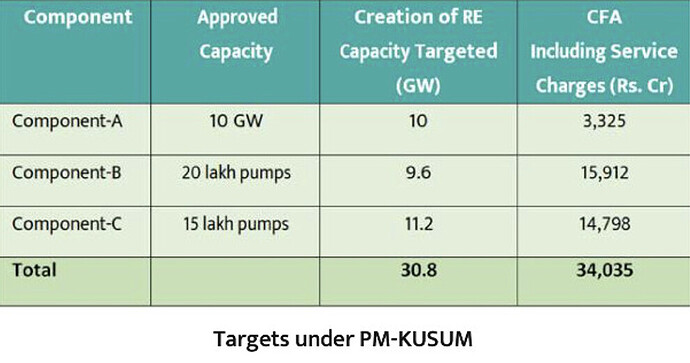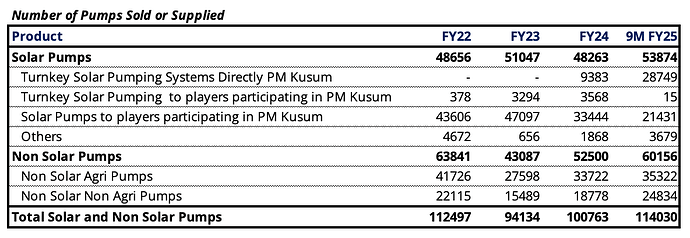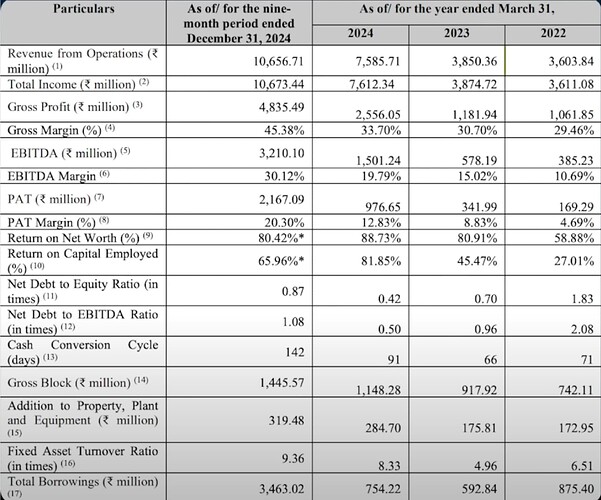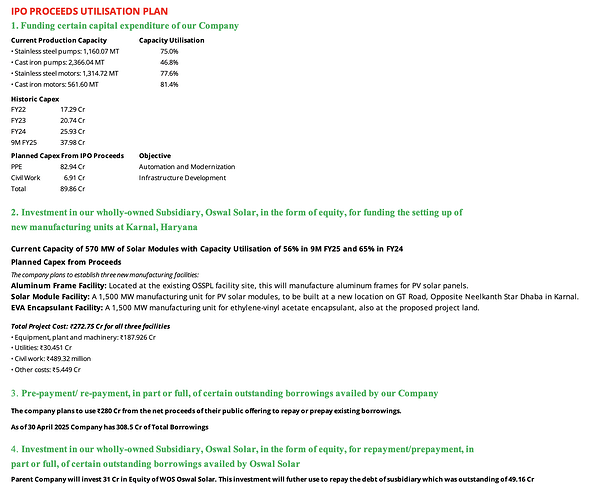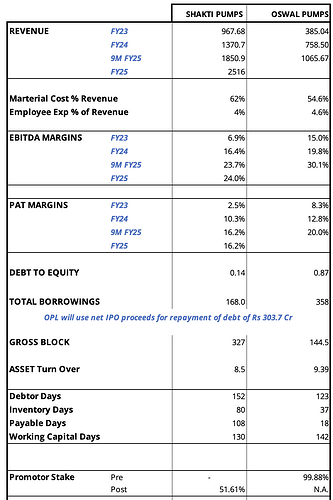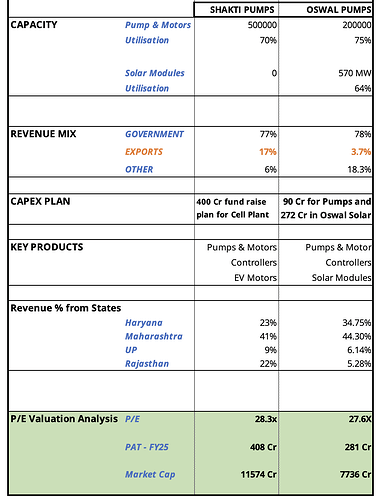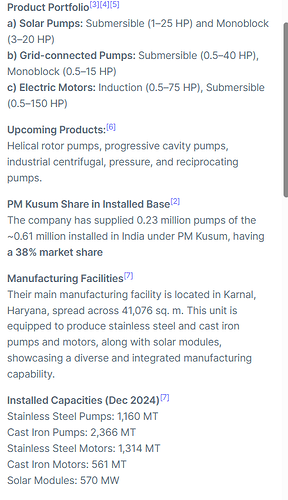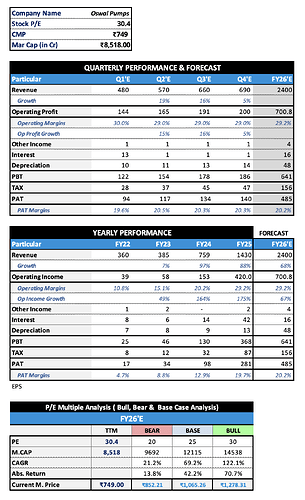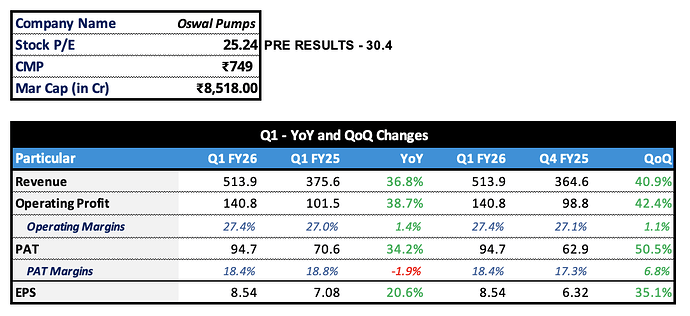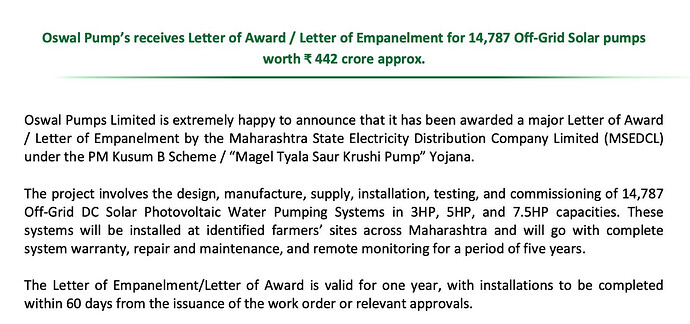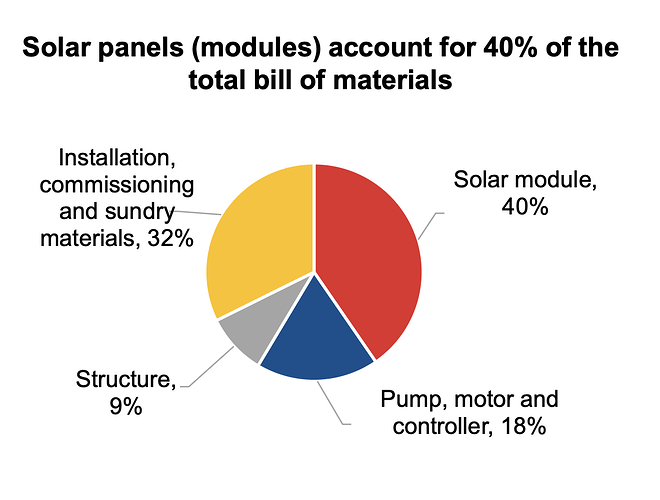Oswal Pumps Ltd is a fast-growing Indian firm engaged in the manufacture of solar pumps and electric motors.
What Does Oswal Pumps Do?
- Manufactures different kinds of pumps: These include solar pumps, electric pumps, and motors.
- Markets under the ‘Oswal’ label.
- Has more than 22 years of experience in pump manufacturing and design.
Where are their pumps used?
- Farms: For irrigating fields and crops.
- Homes: For gardens, fountains, getting water from wells, filling water tanks, and cleaning.
- Businesses: Like shopping malls, offices, and hotels.
- Industries: For things like water treatment, moving water, sewage, and running machines.
Government Policies to support Solar Pumps
- The Indian government introduced the PM Kusum Scheme in 2019 to allow farmers to utilize solar pumps instead of diesel. It saves costs as well as is eco-friendly.
- The scheme finances the installation of solar pumps and the solarizing of pumps.
How did Oswal used this opportunity
- Oswal leveraged its potential to start producing solar pumps for farmers in 2019.
- Markets these pumps to firms and suppliers working under government programs like PM Kusum and the solar pump scheme of Maharashtra.
- Since 2021, Oswal also offers turnkey solar pumping systems, all the solar water pumping equipment needed, directly or via partners.
MANUFACTURING CAPABILITIES
The firm has 2 factories, located in Karnal, Haryana, India, the largest single pump manufacturing plant of 41,076 square meters as of Dec 31, 2024. Its manufacturing plant is located strategically near the big farm states of Haryana, Punjab and Uttar Pradesh.
- Oswal Pumps Ltd, Oswal Estate, Karnal – Electric Motors and Pumps – business started in 2010
- Oswal Solar Structure Pvt Ltd, Link Road, Kutail, Karnal – Solar Modules – Incorporated in 2024
In term of No. of Pumps, company has current capacity of 2 Lakhs pumps and will increase it to 5 Lakh pumps by the end of this year from IPO proceeds.
And for Solar Modules company has 570 MW of module plant which will increased by 600 MW by the end of this year and rest 900 MW by the next financial year.
PRODUCT PORTFOLIO
Solar Submersible Pumps
• They are installed in a fluid body of water, such as a tank or a well.
• They do not need to be primed with water before use (no priming).
• The range of their capacity is from 1 HP to 25 HP.
Market Size
• There is a very fast-evolving market for these pumps.
• It is expected to increase by about 18.7% per annum from 2025 until2030.
• The market would be valued at USD 22 crore in 2030.
Solar Monoblock Pumps
• They are placed on the surface, not submerged.
• The capacity range of the pumps is 3 HP to 20 HP.
Market Size
• The Indian market for the pumps in 2025 was around USD 1 crore.
• It is expected to be around USD 18 crore in 2030.
• Its growth rate annually is around 13.5% from 2025 to 2030.
Grid-Connected Submersible and Mono block Pumps
• These are electric-powered pumps from the grid (not solar).
• Submersible pumps are submerged in water and do not require priming.
• Submersible pumps grid-connected are available from 0.5 HP to 40 HP.
• Grid-integrated mono block pumps are rated 0.5 HP to 15 HP.
Market Size
• The Indian grid-connected submersible pump market in 2025 was around USD 47 crore.
• Its annual market size will increase by 8.3% between 2025 and 2030.
Induction Motors
• Induction motors are an electric motor that operates on alternating current (AC).
• They range in capacity from 0.5 HP to 75 HP.
Market Size
• The Indian market stood at approximately USD 80 crore in 2024.
• It is expected to grow around 13.8% every year between 2024 and2029.
• The market could be USD 150 crore by 2029.
Submersible Motors
• They are made to be used underwater.
• Their horse power capacity is 0.5 HP to 150 HP.
Market Size
• India’s market in 2025 was around USD 108 crore.
• It is forecast to expand by 10.3% annually from 2025 to 2030.
• The sector could be USD 176 crore in 2030.
Company also working for new products which are as follows:
Helical Rotor Pump
- A helical rotor pump is a type of pump that is used to transport thick liquids like chemicals and sludge.
- Commonly applied in food processing, sewage, and water treatment plants.
Market Size
• The Indian market for these pumps is worth ₹1,810 crore in 2025.
• It is expected to grow at about 12.8% per annum.
• The market could be ₹3,300 crore in 2030.
Progressive Cavity Pumps (PCP)
- PCP is a pump used in the transfer of all fluid types, from thin to thick.
- Such pumps are valuable in oil and gas, food processing, and water treatment industries due to their ability to move numerous types of materials.
Market Size
• India’s PCP market is around ₹780 crore in 2025.
• It is anticipated to increase by approximately 11.8% annually to 2029to ₹1,370 crore.
Industrial Centrifugal Pump
- These pumps are widely used in large industries in water and other fluid transport.
- Used in chemical plants, power plants, oil and gas, and waste water treatment.
Market Size
• The Indian market stands at ₹3,220 crore in 2025.
• It is anticipated to increase by approximately 14.8% annually.
• The market can reach ₹6,420 crore by 2030.
Pressure Pump
- Pressure pumps are built to generate and maintain high pressure.
- They assist in moving liquids in systems that require high pressure, such as firefighting or industrial applications.
Market Size
• Indian market is ₹560 crore in 2025.
• It is also predicted to increase by 11.8% annually.
• The industry can expand to ₹980 crore by 2030.
Reciprocating Pump
- A reciprocating pump sucks in a measured quantity of fluid and forcesit out using mechanical energy.
- Used in urban water supply, irrigation, fire fighting, air conditioning, water recirculation, and fuel transfer.
Market Size
• Indian market is ₹1,480 crore in 2025.
• Expected to grow by around 12.8% each year.
• The industry can reach ₹2,688 crore in 2030.
INDUSTRY OVERVIEW
1. Indian Submersible Pump Market
- Submersible pumps are underwater machines that function to suckand move water or other fluids.
- Such pumps are increasingly needed in India since the water levels inthe ground are decreasing, and more bore wells are being used.
- They are applied in the treatment of water, mining, and for residential water supplies in urban and rural settings.
- During 2019-2024, this market flourished, growing by 34.2% annually and had a value of around INR 200.7 billion in 2025 (around 5% of the world market).
- The size of the market will be INR 330.4 billion in 2030, growing at a rate of around 10.5% between 2025-2030.
2. Global Submersible Pump Market
- Globally, the pumps are applied primarily for irrigation, waste water, sewage treatment, drilling, and flood control.
- The international market will grow at 7.5% per annum between 2024 and 2029 and touch INR 1.8 trillion in 2029.
3. Indian Pump Market: Present and Future
- The Indian pump market size was INR 380.5 billion in 2025.
- The market is anticipated to reach INR 591.9 billion by 2030, expanding by 9.2% year-on-year.
- Pumps play a crucial role in several industries like agriculture, industry, and construction.
- New government schemes and increased infrastructure are driving pump demand.
- There is also focus on the design of pumps for particular application, which helps with customisation and efficiency.
- Government programs to improve water supply and sanitation are also increasing pump use.
4. India Electric and Induction Motor Market
- Electric motors power pumps and also find application in electronics, automobiles, industries, and farm agriculture.
- The global electric motor industry is growing at approximately 7% per annum and is likely to be approximately US$ 219.4 billion in 2029.
- The Indian electric motor market was approximately US$ 4.1 billion in size and was anticipated to reach US$ 8.0 billion in 2030 at a growth rate of 14.3% per annum.
- Induction motors (which find very extensive applications in pumps) are also growing in the Indian market at about 13.8% every year until 2030.
5. Pumps Available in Indian Market
- The Indian market is divided into industrial pumps, agricultural pumps, and domestic pumps.
- Agricultural pumps are increasing most rapidly, growing at 8.4% per annum.
6. The Global Pumps Market
- Globally, the pumps industry was INR 6.1 trillion in 2024 and will be INR 7.97 trillion by 2029.
- The market is growing at a rate of about 5.6% per year due to industrialisation, urbanisation, and growing water purification needs.
- Increased use of pumps in renewable energy like solar water pumps and smart pumps with additional features.
Lets talk about Solar Pumps Opportunity Size:
Total Addressable market is around $45 Billion
This shows huge market is still untapped and there is export market is also present. So there is no issue with market size, huge opportunity is there to expand.
PM KUSUM Yojana – A Key growth driver for Oswal Pump’s Business
- Launched in 2019 by MNRE
- Plan is to provide energy security to Indian farmers, with India’s pledge of Power to be produced from non-fossil-fuel resources to 50% by 2030.
- The scheme aims at the development of aggregate solar power capacity of 34.8 GW as of 31st March, 2026, with central financial support of Rs. 34,422 crore.
PM-KUSUM scheme has three components:
-
Component A: Installation of 10,000 MW of decentralised solar ground/stilt-mounted power plants on farmers’ not utilised, fallow, pasture, marshy, or arable lands.
-
Component-B: For Standalone Solar Agriculture pump installations of 17.50 Lakh. Standalone Solar Agriculture pumps up to 7.5 HP capacity installation for replacement of existing diesel Agriculture pumps / irrigation systems in off-grid locations. Installation of pumps with higher capacity than 7.5 HP is also feasible, but the financial support would be up to 7.5 HP capacity.
Central Financial Assistance (CFA):
- For Component B and individual pump solarisation under Component C:
- 30% of the benchmark price or tender-found price (lower of the two) in the majority of states
- 50% in North Eastern States, Jammu & Kashmir, Ladakh, Himachal Pradesh, Uttarakhand, Lakshadweep, and A&N Islands
State Support:
- States/UTs must fund at least 30% of the cost, for which the beneficiary must pay the balance
Rest 40% comes from farmers
30:30:40 (Central: State: Farmer)
- Component C: Solarisation of 35 Lakh Grid Connected Agriculture Pumps through (i) Individual Pump Solarisation and (ii) Feeder Level Solarisation.
Procurement Based Incentive (PBI): DISCOMs receive 40 paise/kWh or Rs. 6.60 lakhs/MW/year (minimum of these two) for buying solar/renewable power under this scheme.
Customer Base
- Revenues from government clients moved up to 78.5% in 9MFY25 from 45.6% in FY 24, as institutional clients decreased.
- Revenues from exports and distribution also remained constant, contributing 10–11% and 3–11% respectively in the periods, indicating consistency in these revenues despite overall customer mix changing radically from 43.37% to 7.15%, indicating a change in strategy towards government business.
Institutional Customers includes players participating in the PM Kusum Scheme.
We can say company’s 85-87% of revenue is coming from Kusum Scheme.
KEY STRENGTH
1. Leadership in the solar powered farm pump industry
OPL is a very rapidly growing Indian firm that manufactures solar-powered irrigation pumps for farming. Its operations have grown very rapidly over the course of the last three years, from 2022 to 2024, with its top line expanding by about 45% per annum.
2. Fastest Growing vertically integrated Manufacturer:
The firm conducts much business in-house, manufacturing the components of their pumps in-house and manufacturing solar panels for solar pumps as well. They also collaborate with their business partner company Walso Solar Solutions Pvt Ltd, which manufactures the mounting parts and other necessary parts required for complete solar pump sets. Doing business this way assists the firm in manufacturing new products, reducing costs, and achieving better profits.
3. Outstanding Engineering and Design Skills:
The company has a strong design and engineering force of 20 individuals who strive to develop better product designs and lower costs through new ideas. Firm also has spent money on high-end computational fluid dynamics and seismic analysis simulation software in an effort to make our products of better quality.
4. Established Market Presence and Wide Distribution Network:
Oswal Pumps has a good customer base in agricultural states like Haryana, and the company is also expanding in Maharashtra, Uttar Pradesh, Rajasthan, and Punjab. They derive the majority of sales from Haryana and Maharashtra. They have almost 925 distributors and special shop outlets called Oswal Shoppes to cater to more individuals. The company also exports to 22 other countries, including Australia, Egypt, Iraq, and Saudi Arabia. Their business is increasing and they are well-established in small and large cities in India.
5. Experienced Promoter and management team:
Promoters’ experience has been a boon to the company. The company has a seasoned Board of Directors, which has Independent Directors, to help in making critical decisions. Board and senior management leadership and experience have helped the company in leveraging market opportunities and serving its customers more effectively.
RISK FACTORS
1. Government Scheme and Agriculture Sector reliance:
Company’s revenue is primarily dependent on tenders under PM Kusum Scheme, and cancellation or reduced allocation under the scheme can have a material impact on its business and financial performance. The company derives over 90% of its revenue from the agriculture sector and is therefore significantly exposed to adverse conditions prevailing in the agriculture sector, which can have a material impact on its business and financial performance.
2. Regional Dependence and Political Risks:
Major of the company’s top line is in Maharashtra, Haryana, Uttar Pradesh, and Rajasthan; negative regional trends in these states would materially affect its business and financial performance.
3. Raw Material Price Fluctuations and Supplier Dependency
Company has high dependence on top 5 suppliers i.e. approx 50% if there while be any disruption it will leads to shortages and higher cost. Raw Material cost is also huge in company business, if the prices of raw material increases company’s margins got reduced significantly.
4. Risk of High Customer Concentration:
The company’s business is highly dependent on its top 5 customers, which contribute over 70% of revenues in recent times; the departure of any of its top customers would have a major impact on its financial and operating performance.
5. Negative Cash Flow and High Trade Receivables and Payables:
Company has huge negative cash flow from operations majorly because of high trade receivables and high Inventory. If this continues it will create liquidity problem for the company.
BRIEF OVERVIEW OF MANAGEMENT AND KMPs
Vivek Gupta is the Promoter, Chairman and Managing Director of the company. He was appointed as a director of the company on September 22, 2006. He has over 18 years of experience in the business of pumps manufacturing.
Amulya Gupta is a Whole-time Director and Promoter of the company. He joined the company in August 2019. He has over 5 years of experience in the manufacturing of pumps.
Shivam Gupta is a Whole-time Director and Promoter of the company. He was appointed as a Director on December 31, 2022. He was appointed as a Director of the company in February 2022. He has more than 3 years of experience in the pumps manufacturing industry.
Sandeep Garg was appointed as an Independent Director of the Company. He is a member of the Board w.e.f. August 7, 2024. He has over 35 years of experience in the energy sector and is currently the Deputy Executive Director (Technical) of the Society of Indian Automobile Manufacturers.
Kanchan Vohra is an Independent Director of the company. She is a Director as of August 7, 2024. She is a lawyer with over 5 years of experience. Vikas Modi is also a Non-Executive Director of the company. He was appointed to the Board on August 7, 2024. He is a finance and audit professional with 19 years of experience.
Subodh Kumar is the Company’s Chief Financial Officer. He was appointed into the company on May 15, 2024. He has over 13 years of experience in finance and accounts.
Anish Kumar is the company secretary and compliance officer of the company. He became a member of the company on 2nd May 2024. He possesses over 7 years of experience in secretarial compliance handling.
FINANCIAL OVERVIEW
- Company’s Revenue has grown by 45.7% CAGR over 3 years.
- EBITDA Margins has expanded significantly from 10% to 30%. This shows company is working on increasing efficiency.
- Company’s cash conversion cycle has increased, this needs an improvement.
- Company’s D/E increased significantly majorly because of expansion plan and growth in business but company will pay off debt from the IPO proceeds. This will improve D/E ratio again.
SOME MORE INSIGHTS
- Oswal Pump is the only company with turnkey solar projects.
- Company has 1100 Crores of Government orders (212 Crores order received from Haryana) + Private exports and others include- 20-25% of business- running business, 3200 Crores LOIs under pipeline.
- Government is coming with Kusum 2.0 Yojana. It will be more aggressive and with more opportunities. First meeting for Kusum 2 was done on 25th April with Government. Company has 75-80% of revenue from Kusum Yojna. Government is working to make more smooth the payment terms and process in Kusum 2.0.
- There is huge opportunity in the export market but we are unable to tap because of capacity contraint. But company is working to increase share of exports.
- In 9M FY25 60-70% growth in exports.
- Exports margins more or less equal or lower.
- Priority is to fulfil domestic demand first and export on other hand.
- Company has current capacity of 2 Lakhs pumps and will increase it to 5 Lakh pumps by the end of this year from IPO proceeds.
- And Currently has 570 MW of module plant which will increased by 600 MW by the end of this year and rest 900 MW by the next financial year.
- Company will be cash flow positive by FY26.
- After this company will not needed to do capex till FY2030 as will have sufficient capacity.
- Company currently has 300 Exclusive stores in India and has plan to increase it to 2000 Stores by next 1-2 years.
- Company has taken debt in FY24 of around 300 Cr for working capital only and has to repay it whole from the IPO proceeds.
- And amount kept aside as General Corporate Purpose will also be used as Working capital when needed.
- Management said demand is so huge that it will not affected by any competition.
- Current Margins are sustainable.
Cost Structure (assume it for 100 Rs cost turnkey project)
- 15 Rs cost- Pump motor controller
- 35-40 Rs- Solar Module
- 10-12- Solar Structure
- 7-8 Rs- BOS
- Logistics, Warehousing, Warranty Cost, etc- Remaining cost and Profits
Under Kusum Scheme company has only liable for 5 Years of Warranty for solar modules. Whereas other players claim for 15-20 Years of warranty.
Gross Margins structure for different pumps and different markets
- Solar Pumps – 45-46%
- Non Solar Pumps – 27-28%
- Exports – 34-35%
- Private Solar Pumps – 38-39%
- Turnkey – 40-41%
IPO PROCEEDS UTILISATION PLAN
PEER2PEER
Disclosure: Invested since IPO; Please do your own Due Dilligence!

